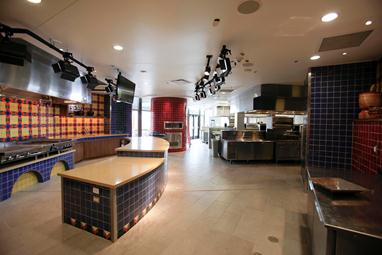A Cooking School for the Americas and a Swiftly Turning Planet
31 October 2010
 Culinary leaders from the Western Hemisphere gathered last month in San Antonio to celebrate El Sueño, The Culinary Institute of America’s mission to promote Latino diversity in the foodservice and hospitality industries.
Culinary leaders from the Western Hemisphere gathered last month in San Antonio to celebrate El Sueño, The Culinary Institute of America’s mission to promote Latino diversity in the foodservice and hospitality industries.
The Culinary Institute of America celebrated the official opening of its expanded 30,000-square-foot campus in San Antonio, Texas, in October 2010 with a festival that included food, music, a healthy-snack competition for local high-school students and culinary demonstrations by chefs ranging from Rick Bayless to Johnny Hernandez. The opening marked the completion of the second phase of the CIA's El Sueño initiative that was launched in San Antonio to promote Latino diversity in the foodservice industry.
The CIA, San Antonio was created in 2007 when San Antonio entrepreneur and philanthropist Kit Goldsbury presented the college with the largest-ever gift in private culinary education. This gift both founded the campus and enabled its expansion. Goldsbury joined college President Dr. Tim Ryan, CMC; CIA Board of Trustees Chairman Cameron Mitchell; and San Antonio Mayor Julian Castro for the grand-opening ceremony and ribbon-cutting.
“There's a foodservice industry reality that we'd like to change,” said Ryan in his opening remarks. “Depending on where you live, 25% to 75% of kitchen and restaurant workers in the foodservice industry are Latino. However, just a small fraction of them rise through the ranks to leadership and ownership positions because they often lack the required education. The CIA is here to support an important mission—to elevate Latin American cuisines to their rightful places among the great cuisines of the world, and to provide access to a world-class CIA education to young Latinos, so that they can assume the mantle of culinary leadership in the generations to come.”
The campus expansion contains a number of world-class facilities to support the college’s 30-week culinary-arts-certificate program currently offered in San Antonio. The first floor features three new teaching kitchens, two skills kitchens that were designed to support the CIA’s core curriculum programs, and a one-of-a-kind Latin Kitchen that is unlike any other currently available in the world.
With professional facilities located both indoors and outdoors, the Latin Kitchen is the world’s premiere culinary facility for educating students and professionals about the indigenous cooking techniques of Mexico and Latin America. Outdoors, the facility showcases specialized equipment including a wood-fired clay comal for tortillas and a parrilla grill (used for cooking asado, or barbecue, commonly found in South America, particularly Argentina, Chile, Uruguay and Paraguay) and barbacoa pit for traditional roasting techniques. Indoors, the Latin Kitchen captures the heritage of Latin America, with Talavera tile walls, a wood-fired oven, a Latin Foods demonstration theater and six cooking suites.
The second floor of the new facility features a professional bakeshop sponsored by Dunkin' Donuts, classrooms and an additional demonstration theater and conference space that can accommodate up to 350 participants. The bakeshop was made possible by a $1 million pledge by Dunkin' Brands CEO and CIA board member Jon Luther. It will enable the CIA to educate students and industry professionals about traditional Latin American baked goods, which are still unfamiliar to many in North America.
The CIA expansion also features a new computer lab, library and offices for the college's faculty and administration.
The CIA, San Antonio campus is also home to the college's Center for Foods of the Americas (CFA). A research arm of the college, the CFA has two full-time chef researchers—Iliana de la Vega and Elizabeth Johnson-Kossick—who do original research in Mexico and Latin America to document and teach traditional cooking methods. Without such research, many of these traditional techniques can be lost over time. The CIA hopes to preserve and promote this culinary heritage through these initiatives.
The CIA, San Antonio facility has been designed to incorporate many “green” practices, including the use of ionized water for cleaning, a composting machine, a solar array that generates electricity and the use of a recycled water tower to artfully cover the outdoor Latin Kitchen.
In addition to the CIA’s 30-week certificate program in culinary arts, the CIA, San Antonio will offer professional classes such as Peruvian Cuisine and Classic Cuisines of Mexico: Puebla & Oaxaca; the annual Latin Flavors, American Kitchens Leadership Conference; and one-day to week-long culinary Boot Camp programs for food enthusiasts.
For more information about The Culinary Institute of America, San Antonio, visit www.ciaelsueno.com.
Photo caption: The CIA, San Antonio's new Latin Kitchen features a wood-fired oven indoors, as well as a comal, parrilla grill and barbacoa in the adjacent outdoor kitchen. Photo credit: CIA/Michael White
